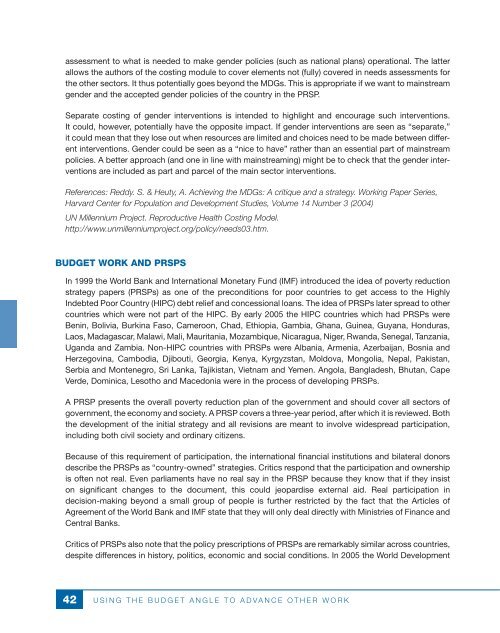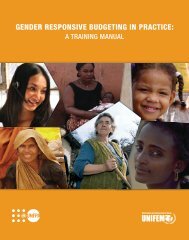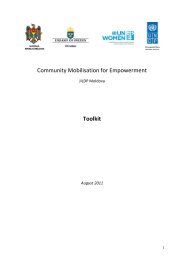Gender Responsive Budgeting and Women's Reproductive Rights ...
Gender Responsive Budgeting and Women's Reproductive Rights ...
Gender Responsive Budgeting and Women's Reproductive Rights ...
Create successful ePaper yourself
Turn your PDF publications into a flip-book with our unique Google optimized e-Paper software.
assessment to what is needed to make gender policies (such as national plans) operational. The latterallows the authors of the costing module to cover elements not (fully) covered in needs assessments forthe other sectors. It thus potentially goes beyond the MDGs. This is appropriate if we want to mainstreamgender <strong>and</strong> the accepted gender policies of the country in the PRSP.Separate costing of gender interventions is intended to highlight <strong>and</strong> encourage such interventions. .It could, however, potentially have the opposite impact. If gender interventions are seen as “separate,” .it could mean that they lose out when resources are limited <strong>and</strong> choices need to be made between differentinterventions. <strong>Gender</strong> could be seen as a “nice to have” rather than an essential part of mainstreampolicies. A better approach (<strong>and</strong> one in line with mainstreaming) might be to check that the gender interventionsare included as part <strong>and</strong> parcel of the main sector interventions.References: Reddy. S. & Heuty, A. Achieving the MDGs: A critique <strong>and</strong> a strategy. Working Paper Series,Harvard Center for Population <strong>and</strong> Development Studies, Volume 14 Number 3 (2004)UN Millennium Project. <strong>Reproductive</strong> Health Costing Model.http://www.unmillenniumproject.org/policy/needs03.htm.Budget work <strong>and</strong> PRSPsIn 1999 the World Bank <strong>and</strong> International Monetary Fund (IMF) introduced the idea of poverty reductionstrategy papers (PRSPs) as one of the preconditions for poor countries to get access to the HighlyIndebted Poor Country (HIPC) debt relief <strong>and</strong> concessional loans. The idea of PRSPs later spread to othercountries which were not part of the HIPC. By early 2005 the HIPC countries which had PRSPs wereBenin, Bolivia, Burkina Faso, Cameroon, Chad, Ethiopia, Gambia, Ghana, Guinea, Guyana, Honduras,Laos, Madagascar, Malawi, Mali, Mauritania, Mozambique, Nicaragua, Niger, Rw<strong>and</strong>a, Senegal, Tanzania,Ug<strong>and</strong>a <strong>and</strong> Zambia. Non-HIPC countries with PRSPs were Albania, Armenia, Azerbaijan, Bosnia <strong>and</strong>Herzegovina, Cambodia, Djibouti, Georgia, Kenya, Kyrgyzstan, Moldova, Mongolia, Nepal, Pakistan,Serbia <strong>and</strong> Montenegro, Sri Lanka, Tajikistan, Vietnam <strong>and</strong> Yemen. Angola, Bangladesh, Bhutan, CapeVerde, Dominica, Lesotho <strong>and</strong> Macedonia were in the process of developing PRSPs.A PRSP presents the overall poverty reduction plan of the government <strong>and</strong> should cover all sectors ofgovernment, the economy <strong>and</strong> society. A PRSP covers a three-year period, after which it is reviewed. Boththe development of the initial strategy <strong>and</strong> all revisions are meant to involve widespread participation,including both civil society <strong>and</strong> ordinary citizens.Because of this requirement of participation, the international financial institutions <strong>and</strong> bilateral donorsdescribe the PRSPs as “country-owned” strategies. Critics respond that the participation <strong>and</strong> ownershipis often not real. Even parliaments have no real say in the PRSP because they know that if they insiston significant changes to the document, this could jeopardise external aid. Real participation indecision-making beyond a small group of people is further restricted by the fact that the Articles ofAgreement of the World Bank <strong>and</strong> IMF state that they will only deal directly with Ministries of Finance <strong>and</strong> .Central Banks.Critics of PRSPs also note that the policy prescriptions of PRSPs are remarkably similar across countries,despite differences in history, politics, economic <strong>and</strong> social conditions. In 2005 the World Development42U s i n g t h e b u d g e t a n g l e t o a d v a n c e o t h e r w o r k





